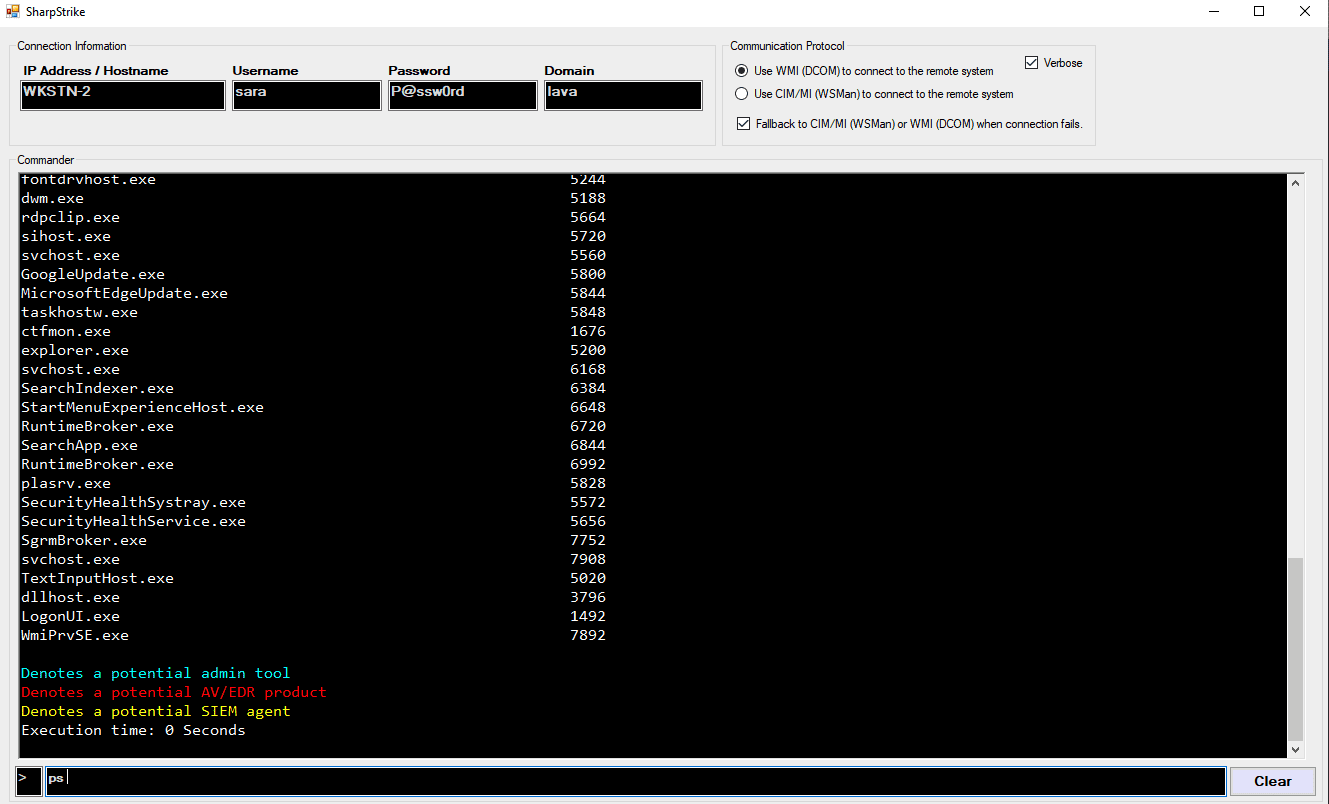
SharpStrike
SharpStrike is a post-exploitation tool written in C# that uses either CIM or WMI to query remote systems. It can use provided credentials or the current user’s session.
Note: Some commands will use PowerShell in combination with WMI, denoted with ** in the –show-commands command.
Introduction
SharpStrike is a C# rewrite and expansion on @Matt_Grandy_‘s CIMplant and @christruncer‘s WMImplant.
SharpStrike allows you to gather data about a remote system, execute commands, exfil data, and more. The tool allows connections using Windows Management Instrumentation, WMI, or Common Interface Model, CIM; well more accurately Windows Management Infrastructure, MI. CIMplant requires local administrator permissions on the target system.
Solution Architecture
SharpStrike is composed of three main projects
- ServiceLayer — Provides core functionality and consumed by the UI layer
- Models — Contains types, shared across all projects
- User Interface — GUI/Console
ServiceLayer
- Connector.cs
This is where the initial CIM/WMI connections are made and passed to the rest of the application
- ExecuteWMI.cs
All function code for the WMI commands
- ExecuteCIM.cs
All function code for the CIM (MI) commands
Function
File Operations:
cat – Reads the contents of a file
copy – Copies a file from one location to another
download** – Download a file from the targeted machine
ls – File/Directory listing of a specific directory
search – Search for a file on a user
upload** – Upload a file to the targeted machine
Lateral Movement Facilitation
command_exec** – Run a command line command and receive the output. Run with nops flag to disable PowerShell
disable_wdigest – Sets the registry value for UseLogonCredential to zero
enable_wdigest – Adds registry value UseLogonCredential
disable_winrm** – Disables WinRM on the targeted system
enable_winrm** – Enables WinRM on the targeted system
reg_mod – Modify the registry on the targeted machine
reg_create – Create the registry value on the targeted machine
reg_delete – Delete the registry on the targeted machine
remote_posh** – Run a PowerShell script on a remote machine and receive the output
sched_job – Not implimented due to the Win32_ScheduledJobs accessing an outdated API
service_mod – Create, delete, or modify system services
ls_domain_users*** – List domain users
ls_domain_users_list*** – List domain users sAMAccountName
ls_domain_users_email*** – List domain users email address
ls_domain_groups*** – List domain user groups
ls_domain_admins*** – List domain admin users
ls_user_groups*** – List domain user with their associated groups
ls_computers*** – List computers on current domain
Process Operations
process_kill – Kill a process via name or process id on the targeted machine
process_start – Start a process on the targeted machine
ps – Process listing
System Operations
active_users – List domain users with active processes on the targeted system
basic_info – Used to enumerate basic metadata about the targeted system
drive_list – List local and network drives
share_list – List network shares
ifconfig – Receive IP info from NICs with active network connections
installed_programs – Receive a list of the installed programs on the targeted machine
logoff – Log users off the targeted machine
reboot (or restart) – Reboot the targeted machine
power_off (or shutdown) – Power off the targeted machine
vacant_system – Determine if a user is away from the system
edr_query – Query the local or remote system for EDR vendors
Log Operations
logon_events – Identify users that have logged onto a system
* All PowerShell can be disabled by using the –nops flag, although some commands will not execute (upload/download, enable/disable WinRM)
** Denotes PowerShell usage (either using a PowerShell Runspace or through Win32_Process::Create method)
*** Denotes LDAP usage – “root\directory\ldap” namespace
Changelog v1.2
- Fixed bugs in the Console version
Install & Use
Copyright (C) 2021 iomoath